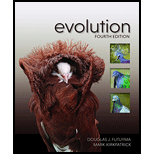
Evolution
4th Edition
ISBN: 9781605356051
Author: Douglas Futuyma, Mark Kirkpatrick
Publisher: SINAUER
expand_more
expand_more
format_list_bulleted
Concept explainers
Question
Chapter 15, Problem 3PDT
Summary Introduction
To determine: The way in which differential expression of and regulation by Hox genes contribute to mosaic evolution in which different segments of an animal body plan evolve different morphologies.
Introduction: Hox genes are those related genes group that contain conserved deoxyribonucleic acid sequences (homeobox). These genes are responsible for controlling an embryo’s body plan or segmentation along the head-tail axis.
Expert Solution & Answer
Want to see the full answer?
Check out a sample textbook solution
Students have asked these similar questions
How might differential expression of and regulation by Hox genes contribute to mosaic evolution in which different segments of an animalbody plan evolve different morphologies?
How are the mammalian Hox genes related to the homeotic genes of Drosophila? How do the Hox genes contribute to morphological diversity in vertebrates, give an example.
Which of the following is NOT true regarding Hox genes.
A) The sequence they appear in their corresponding chromosomes is the same order of their expression along the front to back of the developing animal.
B) Homologues of the same Hox genes found in flies can be found in humans.
C) Hox genes are only found in animals with bilateral symmetry.
D) Animals with more complex body plans tend to have more sets of Hox genes through gene duplication events.
Knowledge Booster
Learn more about
Need a deep-dive on the concept behind this application? Look no further. Learn more about this topic, biology and related others by exploring similar questions and additional content below.Similar questions
- What is trichomacy in primates and why is this considered a beneficial mutation?arrow_forwardRunt is a Drosophila gene involved in development. Mutation of runt leads to an embryonic lethal phenotype in which every other segment in the body plan is missing. What class of developmental genes does runt belong to? O a) Pair-rule genes O b) Segment polarity genes Oc) Homeotic genes O d) Gap genesarrow_forwardWhat controls hox genes expression in vertebrates?arrow_forward
- Considering the evolution of species, could a gene that is conserved from yeast to humans have evolved to confer some of the complex traits that we observe in modern animals, like multicellularity? Briefly explain.arrow_forwardThe evolution / development of the skeletal system of the vertebrate is an example of the process of cellular specialization. This refers to the fact? a) all the ectoderm cells remain the same b) the cells derived from the endoderm to form osteocytes that secrete collagen c) the cells of the endoderm form chondrocytes that become notochord d) genes are activated or surpressed in the cells from the original mesoderm causing them to become chondrocytes and osteocytes the stem cells that sequentially produce the componets of the skeleton e) genes are not involved in this function?arrow_forwardGiven the distribution of Hox genes among animals, what would you predict about the number and type of Hox genes in the common ancestor of all animals?arrow_forward
- In the late 1980s, this gradient hypothesis was united with a genetic approach to the study of Drosophila embryogenesis. If there were gradients, what were the morphogens whose concentrations changed over space?arrow_forwardWhich gene family was found to control the development and differentiation of limbs in vertebrate lineages? A) Hox B) Sonic hedgehog C) Noggin D) Eyelessarrow_forwardA C. elegans (nematode) gene called par-1 helps todetermine the AP axis of the animal early in development. Scientists determined that par-1 is pleiotropic—it also has a later function in forming the vulva of theadult animal. How could researchers circumvent thelethality of par-1− mutants to observe the later function of the par-1 gene? (Hint: C. elegans larvae caneat bacteria expressing RNAi for any gene.)arrow_forward
- ____ genes are regulated by segmentation genes and control the development of specific structures within particular segments. Each of these genes contains a highly conserved 180-base pair region called the ____. Examples of such genes are: ____ which regulates the development of wings in the thoracic segments and ____ which regulates the development of compound eyes and ommatidia.arrow_forwardAn organism has a relatively large number of Hox genes in its genome. Which of the following is true of this organism? Select one: А. Its Hox genes cooperate to bring about sexual maturity at the proper stage of development. В. Most of its Hox genes owe their existence to gene fusion events. С. The organism must have multiple paired appendages along the length of its body. D. These genes are fundamental, and are expressed in all cells of the organism. E. The organism has the genetic potential to have a relatively complex anatomy.arrow_forwardYou have identified a Drosophila gene that is expressed exclusively in the odd-numbered "stripes" in the cellular blastoderm. Assuming that this gene is not redundant, what would be the most likely phenotype cause by a loss-of-function mutation in this gene? an embryo missing odd numbered segments an adult fly with a second pair of wings instead of halteres an embryo with two anterior ends an embryo missing even-numbered segments an embryo missing larval segments 3-10arrow_forward
arrow_back_ios
SEE MORE QUESTIONS
arrow_forward_ios
Recommended textbooks for you
 Biology: The Dynamic Science (MindTap Course List)BiologyISBN:9781305389892Author:Peter J. Russell, Paul E. Hertz, Beverly McMillanPublisher:Cengage Learning
Biology: The Dynamic Science (MindTap Course List)BiologyISBN:9781305389892Author:Peter J. Russell, Paul E. Hertz, Beverly McMillanPublisher:Cengage Learning

Biology: The Dynamic Science (MindTap Course List)
Biology
ISBN:9781305389892
Author:Peter J. Russell, Paul E. Hertz, Beverly McMillan
Publisher:Cengage Learning
Mitochondrial mutations; Author: Useful Genetics;https://www.youtube.com/watch?v=GvgXe-3RJeU;License: CC-BY